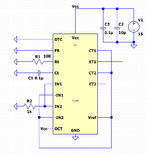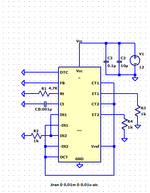sabu31
Advanced Member level 1
Dear All,
I am trying to get TL494 to generate 120Khz PWM in complementary mode with 50% duty Ratio. However, I am getting overlap in the waveform and also cannot reduce PWM to below 10kHz without complete overlap. Moreover, there is an offset of 1V in PWM output. I am attaching the circuit diagram and waveforms for your reference. Please let me know what changes are required or any references.
I am trying to get TL494 to generate 120Khz PWM in complementary mode with 50% duty Ratio. However, I am getting overlap in the waveform and also cannot reduce PWM to below 10kHz without complete overlap. Moreover, there is an offset of 1V in PWM output. I am attaching the circuit diagram and waveforms for your reference. Please let me know what changes are required or any references.



